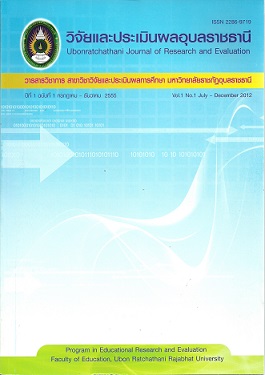การพัฒนารูปแบบการจัดการเรียนรู้แบบร่วมมือด้วยเทคนิค STAD เพื่อพัฒนาทักษะการผันวรรณยุกต์ กลุ่มสาระการเรียนรู้ภาษาไทย สำหรับนักเรียนชั้นประถมศึกษาปีที่ 2 โรงเรียนบ้านหนองแสง สำนักงานเขตพื้นที่การศึกษาประถมศึกษาอุบลราชธานี เขต 5 85-93
คำสำคัญ:
การพัฒนารูปแบบการจัดการเรียนรู้แบบร่วมมือด้วยเทคนิค STAD , การผันวรรณยุกต์ , ภาษาไทยบทคัดย่อ
การวิจัยและพัฒนาครั้งนี้มีวัตถุประสงค์ 1) เพื่อสร้างรูปแบบการจัดการเรียนรู้แบบร่วมมือด้วยเทคนิค STAD เพื่อพัฒนาทักษะการผันวรรณยุกต์ สำหรับนักเรียนชั้นประถมศึกษาปีที่ 2 2) เพื่อเปรียบเทียบทักษะการผันวรรณยุกต์ของนักเรียนกลุ่มทดลองก่อนเรียนและหลังเรียน 3) เพื่อเปรียบเทียบทักษะการผันวรรณยุกต์ของนักเรียนกลุ่มทดลอง
ที่ใช้รูปแบบการจัดการเรียนรู้แบบร่วมมือด้วยเทคนิค STAD กับนักเรียนกลุ่มควบคุมที่ได้รับการจัดการเรียนรู้แบบปกติ
ประชากรและกลุ่มตัวอย่างที่ใช้ในการศึกษาในครั้งนี้ เป็นนักเรียนชั้นประถมศึกษาปีที่ 2 โรงเรียนบ้านหนองแสง สำนักงานเขตพื้นที่การศึกษาประถมศึกษาอุบลราชธานี เขต 5 ภาคเรียนที่ 1 ปีการศึกษา 2555 จำนวน 262 คน กลุ่มตัวอย่าง 76 คน เป็นกลุ่มทดลอง 38 คน กลุ่มควบคุม 38 คน ซึ่งได้มาโดยวิธีการสุ่มอย่างง่าย (Simple Random Sampling) เครื่องมือที่ใช้ในการเก็บรวบรวมข้อมูล ได้แก่ แบบวัดผลสัมฤทธิ์ทางการเรียน จำนวน 30 ข้อ ซึ่งมีค่าความยากง่ายอยู่ระหว่าง 0.27–0.77 ค่าอำนาจจำแนก 0.23–0.80 และค่าความเชื่อมั่นเท่ากับ 0.82 และแบบทดสอบการพัฒนาทักษะการผันวรรณยุกต์ จำนวน 30 ข้อ มีค่าความยากง่ายอยู่ระหว่าง 0.23–0.79 ค่าอำนาจจำแนก 0.23–0.80 ค่าความเชื่อมั่นเท่ากับ 0.86 สถิติที่ใช้ในการวิจัยคือ สถิติพื้นฐาน ค่าร้อยละ ค่าเฉลี่ย ส่วนเบี่ยงเบนมาตรฐาน และการทดสอบค่า t
ผลการวิจัยพบว่า
การพัฒนารูปแบบการจัดการเรียนรู้แบบร่วมมือด้วยเทคนิค STAD เพื่อพัฒนาทักษะการผันวรรณยุกต์ กลุ่มสาระการเรียนรู้ภาษาไทย สำหรับนักเรียนชั้นประถมศึกษาปีที่ 2 โรงเรียนบ้านหนองแสง สำนักงานเขตพื้นที่การศึกษาประถมศึกษาอุบลราชธานี เขต 5 สาระที่ 4 หลักการใช้ภาษาไทย เรื่อง การผันอักษรกลาง อักษรสูง อักษรต่ำ สรุปผลการวิจัยได้ดังนี้
- ได้รูปแบบการจัดการเรียนรู้แบบร่วมมือด้วยเทคนิค STAD เพื่อพัฒนาทักษะการผันวรรณยุกต์ ประกอบไปด้วย 5 ขั้น ดังนี้
1.1 ขั้นนำเสนอความรู้ ครูนำเสนอบทเรียนต่อนักเรียนทั้งชั้นด้วยการบรรยาย โดยใช้วิธีการสอนผันวรรณยุกต์ด้วยนิ้วมือ
1.2 ขั้นแลกเปลี่ยนเรียนรู้ แบ่งกลุ่มนักเรียนคละเพศ และคละตามความสามารถ ศึกษา
ใบความรู้และทำแบบฝึก เน้นการเรียนรู้และทำงานร่วมกัน
1.3 ขั้นประเมินความสามารถ เมื่อสอนจบไปในแต่ละแผน ครูจะทำการทดสอบโดยแยกโต๊ะนั่งเดี่ยว ต่างคนต่างสอบจะช่วยเหลือกันไม่ได้ นักเรียนแลกเปลี่ยนกระดาษคำตอบเปลี่ยนกันตรวจ แล้วนำคะแนนของสมาชิกทุกคนในกลุ่มมารวมกันเป็นคะแนนกลุ่ม
1.4 ขั้นพัฒนาผู้เรียน เปิดโอกาสให้ผู้เรียนได้พัฒนาความสามารถของตนอย่างเต็มที่ ผู้เรียนสามารถปรับปรุงคะแนนของตนเองให้สูงขึ้น
1.5 ขั้นเชิดชูคนเก่งเสริมแรงคนด้อย พิจารณาผลรวมของการปรับปรุงคะแนนของสมาชิก
ในกลุ่ม กำหนดระดับผลสำเร็จตามคะแนนที่ได้ของกลุ่ม โดยให้ดาวสำหรับกลุ่มที่ได้คะแนนสูงสะสมไปเรื่อยๆ จนจบเนื้อหา ถ้ากลุ่มไหนได้คะแนนสูงสุดจะได้รับรางวัลจากครู
- การเปรียบเทียบทักษะการผันวรรณยุกต์ของนักเรียนกลุ่มทดลองหลังที่ได้รับการจัดการเรียนรู้ตามรูปแบบการเรียนรู้แบบร่วมมือด้วยเทคนิค STAD มีทักษะการผันวรรณยุกต์สูงกว่าก่อนเรียน อย่างมีนัยสำคัญทางสถิติที่ระดับ .05
- การเปรียบเทียบทักษะการผันวรรณยุกต์ของนักเรียนกลุ่มทดลองที่ใช้รูปแบบการจัดการเรียนรู้แบบร่วมมือด้วยเทคนิค STAD มีทักษะการผันวรรณยุกต์สูงกว่านักเรียนกลุ่มควบคุมที่ได้รับการจัดการเรียนรู้แบบปกติ อย่างมีนัยสำคัญทางสถิติที่ระดับ .05
เอกสารอ้างอิง
แดเน็กซ์ อินเตอร์คอร์ปอเรชั่น, 2553.
ธนาลัย เธียรวรรณ. การพัฒนาทักษะการอ่านออกเสียงของนักเรียนชั้นประถมศึกษาปีที่ 4 โดยใช้กิจกรรม
กลุ่มร่วมมือแบบ STAD. วิทยานิพนธ์การศึกษามหาบัณฑิต มหาวิทยาลัยมหาสารคาม, 2551.
พิมสิริ บุญมาก. การพัฒนาการจัดกิจกรรมการเรียนรู้แบบร่วมมือเทคนิค STAD เรื่อง การอ่านและเขียนสะกดคำ กลุ่มสาระการเรียนรู้ภาษาไทย ชั้นประถมศึกษาปีที่ 1. วิทยานิพนธ์ครุศาสตรมหาบัณฑิต มหาวิทยาลัยราชภัฏมหาสารคาม, 2554.
ยุทธ ไกยวรรณ์ และ กุสุมา ผลาพรม. พื้นฐานการวิจัย. กรุงเทพฯ: ศูนย์สื่อเสริมกรุงเทพ, 2553.
รัสรินทร์ เสนารถรัฐพงศ์. การจัดกิจกรรมการเรียนรู้แบบกลุ่มร่วมมือ กลุ่มสาระการเรียนรู้ภาษาไทย เรื่อง
การผันวรรณยุกต์ด้วยนิ้วมือ ชั้นประถมศึกษาปีที่ 1. การศึกษาค้นคว้าอิสระการศึกษามหาบัณฑิต มหาวิทยาลัยมหาสารคาม, 2551.
ราณี ศรีโมรา. การเปรียบเทียบความสามารถในการอ่านเพื่อความเข้าใจ และเจตคติต่อการเรียนภาษาไทย โดยใช้การจัดการเรียนรู้แบบร่วมมือวิธีเอสทีเอดีและการจัดการเรียนรู้แบบปกติ. วิทยานิพนธ์
ครุศาสตรมหาบัณฑิต มหาวิทยาลัยราชภัฏเทพสตรี, 2551.
รินรดา จันทะวัน. การพัฒนาแผนการเรียนรู้โดยใช้แบบฝึกทักษะการอ่านเชิงวิเคราะห์ด้วยการเรียนรู้แบบร่วมมือ (STAD) กลุ่มสาระการเรียนรู้ภาษาไทย ชั้นมัธยมศึกษาปีที่ 1. วิทยานิพนธ์ศึกษาศาสตรมหาบัณฑิต มหาวิทยาลัยมหาสารคาม, 2550.
วรรณี โสมประยูร. เทคนิคการสอนภาษาไทย. กรุงเทพฯ: สำนักพิมพ์ดอกหญ้าวิชาการ จำกัด, 2553.
วิชาการ, กรม. การจัดสาระการเรียนรู้กลุ่มสาระการเรียนรู้ภาษาไทยตามหลักสูตรการศึกษาขั้นพื้นฐาน พุทธศักราช 2544. กรุงเทพฯ: โรงพิมพ์คุรุสภาลาดพร้าว, 2546 ก.
. แนวทางการประเมินผลด้วยทางเลือกใหม่ตามหลักสูตรการศึกษาขั้นพื้นฐาน พุทธศักราช 2544 กลุ่มสาระการเรียนรู้ภาษาไทย. กรุงเทพฯ: โรงพิมพ์คุรุสภาลาดพร้าว, 2546 ข.
วิมลรัตน์ สุนทรโรจน์. หลักสูตรและการสอนภาษาไทย. มหาสารคาม: ช้างทอง, 2549.
ดาวน์โหลด
เผยแพร่แล้ว
รูปแบบการอ้างอิง
ฉบับ
ประเภทบทความ
สัญญาอนุญาต
1. บทความที่ตีพิมพ์ในวารสารนี้ได้มีการตรวจสอบการลอกเลียนงานวรรณกรรมแล้ว ไม่เกินร้อยละ 25
2. บทความที่ตีพิมพ์ในวารสารนี้เป็นข้อคิดเห็น ข้อค้นพบของผู้เขียนบทความ โดยผู้เขียนบทความต้องเป็นผู้รับผิดชอบต่อผลทางกฎหมายใด ๆ ที่อาจเกิดขึ้นจากบทความนั้น ๆ
3. บทความ ข้อมูล เนื้อหา รูปภาพ ฯลฯ ที่ได้รับการตีพิมพ์ในวารสารวิจัยและประเมินผลอุบลราชธานี ถือเป็นลิขสิทธิ์ของวารสารวิจัยและประเมินผลอุบลราชธานี หากบุคคลหรือหน่วยงานใดต้องการนำทั้งหมดไปเผยแพร่ต่อหรือเพื่อกระทำการใดๆ จะต้องได้รับอนุญาตเป็นลายลักษณ์อักษรจากวารสารวิจัยและประเมินผลอุบลราชธานีก่อนเท่านั้น และจะต้องมีการอ้างอิงวารสารวิจัยและประเมินผลอุบลราชธานี ฉบับนั้น ๆ ด้วย






